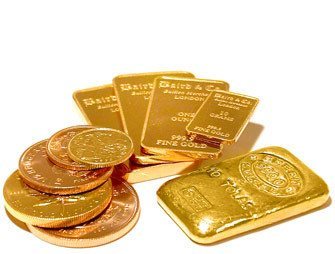
Most people imagine large brick-like bars when they think of gold. In fact the gold bars used on most bank heist films weigh 12.5kg and are worth nearly £1/2million!
Luckily for the average investor bullion bars are available in many sizes to suit even the most modest pocket. Bar weights come in both imperial and metric denominations. The common weights you’ll see are 1g, 2.5g, 5g, 10g, 20g, 1oz, 50g, 100g, 5oz, 250g, 10oz, 500g, 1kg, and 12.5kg.
There are thousands of different producers of bars and many of the top refiners are members of the London Bullion Market Association (LBMA) which provides accreditation and guarantee of quality. Some of the best known manufacturers are Credit Suisse, Johnson Matthey, Pamp Suisse and Umicore. Each may produce bars of equal gold content and weight, but with varying dimensions and shape. All will be regarded as 24 karat which is virtually pure gold and is often quoted as 99.99% pure. Some bar refiners will offer certification and serial numbers on some of the smallest bars, while others only provide documentation for bars of 250g or larger.
The main advantage of investing into gold bars is that you will more often than not receive the most actual gold for your money as their value solely consists of their gold content. However a popular misconception is that bars can be bought exactly at the gold spot price. This is never true unless you are a large central bank dealing in tonnes of gold! In practise, the spot gold price is the benchmark from which all types of investment gold are priced. Gold bars will generally trade at a narrower premium to coins and this premium falls as the size of the bar increases. Obviously when selling back a 1oz gold bar, you will no doubt receive a lower price from a dealer than its equivalent sized coin.
While a gold bar is the most efficient purchase for someone looking to melt down the gold for jewellery, it can present some obstacles for other investors. The very fact that it’s 24 karat gold means that unless the bars are kept in a specialist depository, it can scratch and tarnish. This can affect the price you’ll receive when selling the bar.
Ease in selling your bars can be affected by two other factors. Firstly make sure that you buy a well known manufacturer, as there are many obscure producers whose bars may be more difficult to sell. Secondly, while purchasing larger bars may save a couple of percent off the buy price, you cannot break this bar up if you only want to cash-in some of your investment. You may find a 1kg bar may be more difficult to sell than a 1oz bar as there are fewer buyers.
Finally, unless bought as part of a pension, the profit made on the bullion bars is taxable. If you’re keen to own gold bullion as part of your pension, then bullion bars are the only type of gold that qualifies. Gold coins of any type are not currently permitted into UK pensions. The advantages of Pension gold are that you receive up to 40% discount off the price of bars through tax relief, the bars are in 1oz denominations offering full flexibility and are stored in a licensed gold depository - maintaining the integrity of the bars.








